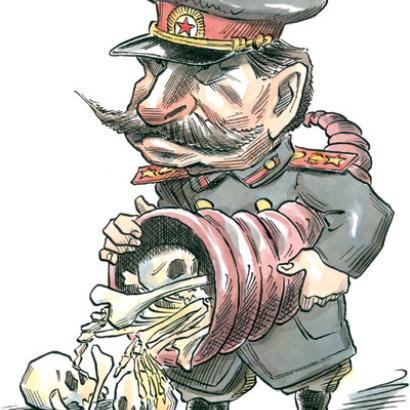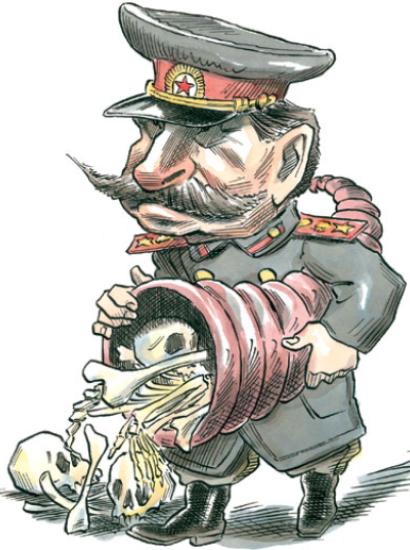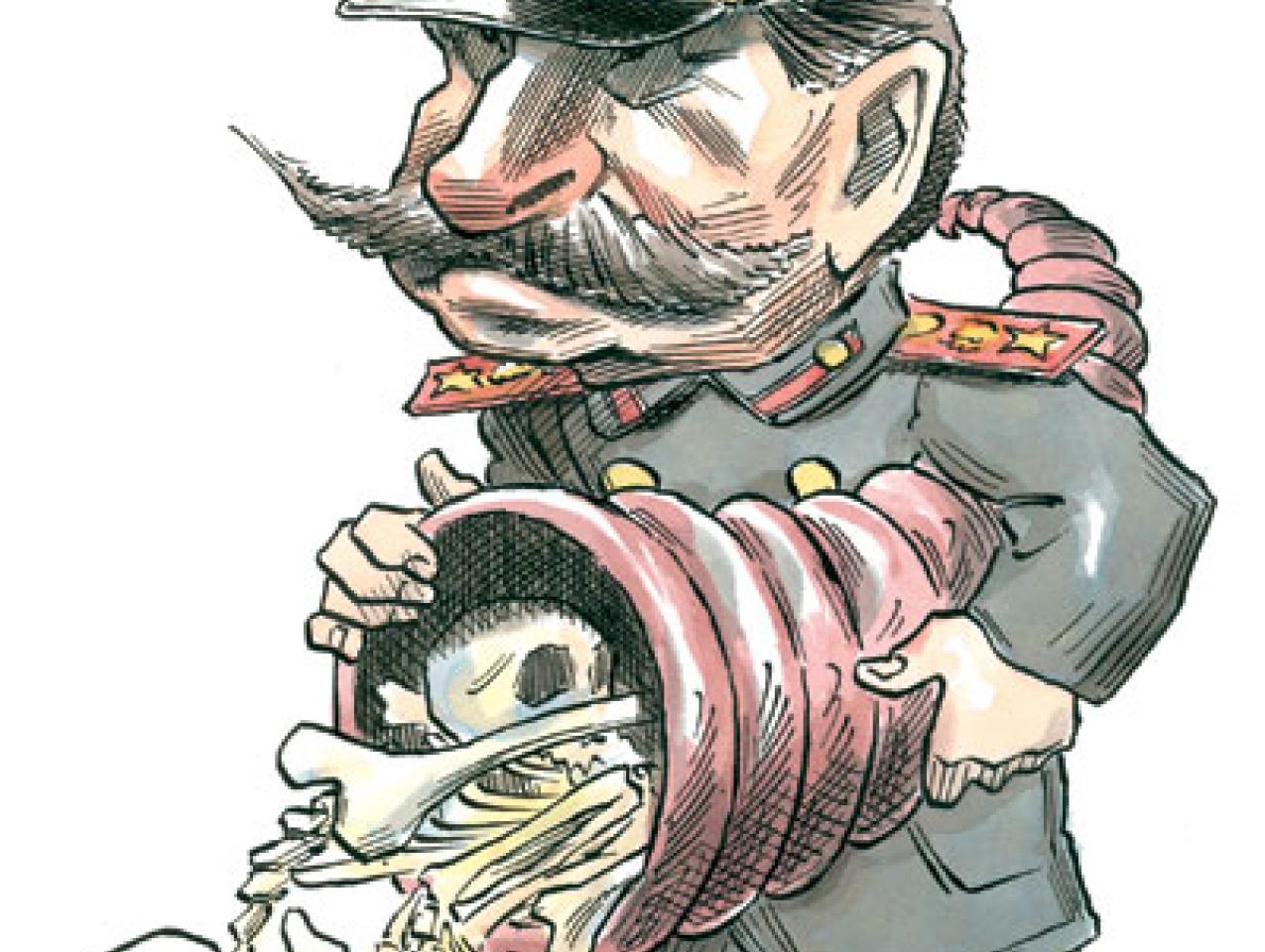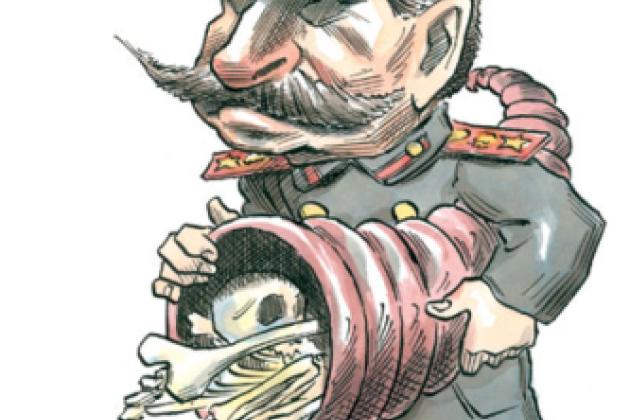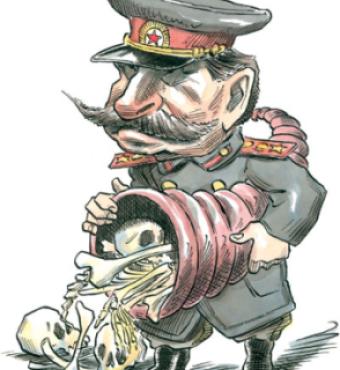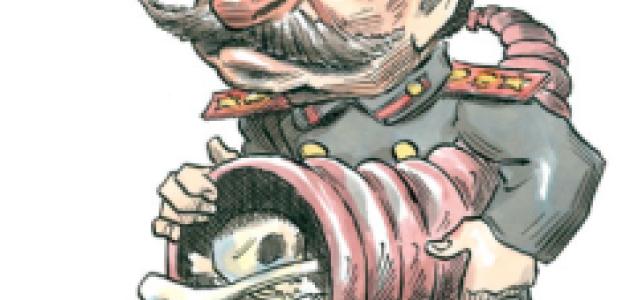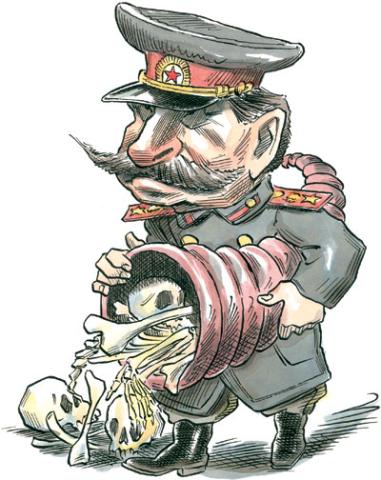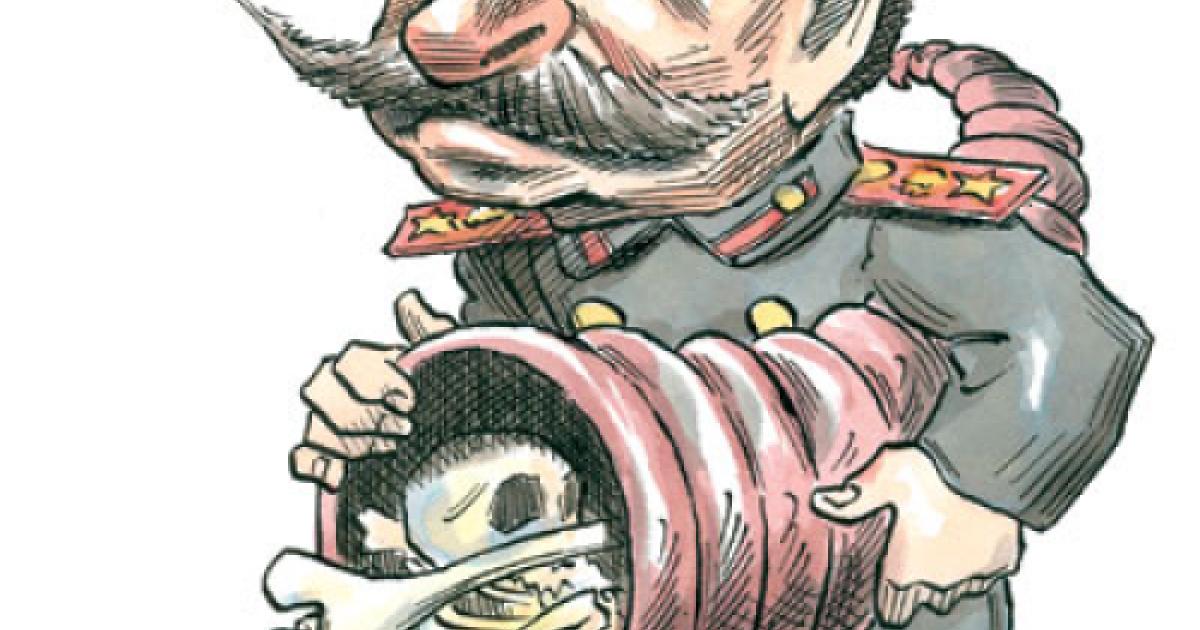- Contemporary
- World
- International Affairs
- US Foreign Policy
- History
Marie Antoinette is notorious for her (apocryphal) advice to the poor of revolutionary France that if they could not afford bread, they should eat cake. Josef Stalin, during the Soviet famine of 1931–34, outdid her. Many of those dying from starvation were idlers, he charged. Their lack of food was a result of their poor work; hence, they did not deserve even bread. They deserved to die. In a speech delivered February 19, 1933, while the famine was raging, Stalin quoted Saint Paul’s remark (incorporated into the Soviet constitutions of 1918 and 1936) that “he who does not work, neither shall he eat.”
In the modern world, such indifference to suffering and lack of empathy for the poor is usually considered an extreme right-wing trait. Here, however, we find it integral to the Communist leaders’ view of the terrible famine of 1931–34. We also find an explanation of why Soviet relief efforts, which did exist and did save some lives, were wholly inadequate to stop the unfolding catastrophe. The Soviet leaders considered many of the dying to be counterrevolutionaries, idlers, or thieves who, as Stalin asserted, deserved either starvation or repression.
The famine of 1931–34 was a major humanitarian catastrophe, claiming almost 6 million victims, as many lives as were lost in the Holocaust. As Aleksandr Solzhenitsyn and others have pointed out, the Soviet victims of terror and starvation in 1930–34 outnumbered the victims of the ghastly era of torture, killings, and incarcerations known as the Great Terror, or Stalinshchina, of 1937–38. The controversy about how Soviet leaders acted during the food crisis continues. Was the famine a result of natural conditions (that is, poor harvests) or a result of conscious steps—a genocidal policy aimed at the Ukrainians, who formed the largest ethnic group among the victims? The poor-harvest theory dominates among Western economic historians, the genocidal-policy argument in Ukraine and among the Ukrainian diaspora.
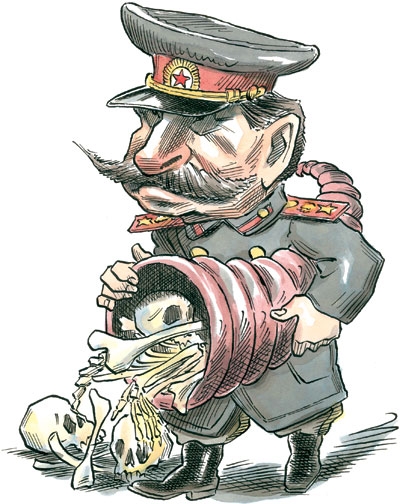
Estimating the Ukrainian famine deaths is difficult because the population registration data are incomplete and a variety of demographic upheavals hit Ukraine between 1926 and the late 1930s. Serious estimates of the number of excess deaths of Ukrainians between the censuses of 1926 and 1937 range from 3 million to 4.5 million. Of those, the number who died of starvation and related diseases in 1931–33 was probably 2 million to 3.5 million. In addition, the demographic losses included the Ukrainian children and their descendants never born because of the famine.
Kazakhs also suffered severely during the famine. About 1.3 million to 1.5 million are thought to have died of starvation or related diseases in 1931–34—fewer than the Ukrainian victims but a much bigger share of the Kazakh population. The Kazakhs lost 35–38 percent of their people— almost two out of every five. There were also a significant number of Russian victims and many from the smaller ethnic groups.
Recent research in Russia, Ukraine, Kazakhstan, and the West has greatly added to our knowledge of the tragic events of 1930–34. One of the many positive consequences of the collapse of the USSR in 1991 was increased access to its archives, some of the papers of which have been copied onto microfilm and collected at the Hoover Institution. Those documents indicate that the Soviet famine resulted from both natural and political circumstances.
ROOTS OF A HUMANITARIAN CRISIS
On the one hand were two very bad harvests (in 1931 and 1932), which caused an extreme shortage of bread, thus generating a potential famine; those bad harvests are overlooked in the Ukrainian narrative. On the other hand, the Soviet leadership worsened the crisis by its actions and lack of action, thus turning a potential famine into an actual famine. Its relief efforts were inferior to those of the tsarist regime in the analogous hunger crisis of 1891–92, and it failed to import grain to feed the starving or to encourage relief efforts by other countries. This was in contrast to the USSR’s behavior during the famines of 1921–22 and 1946–47, when it did permit international humanitarian efforts (led, in 1921–22, by Herbert Hoover). In fact, Soviet leaders, seeking to finance imports of machines and equipment for their industrialization program, actually exported grain despite the famine. In contemporary Ukraine, this is naturally regarded as a major crime.
Moreover, the Soviet leadership banned migration from two badly affected regions, Ukraine and the North Caucasus, thus preventing many people from fleeing the disaster zone. And, alongside the starvation, Soviet leaders continued to pursue a program of mass terror, initiated in 1930, to enforce agricultural collectivization, despite widespread opposition among the peasantry. That program most likely cost 4 million additional people their freedom; most were deported, often to very remote and inhospitable areas, others were sent to prisons or camps, and some were shot.
Soviet leaders considered peasants second-class citizens who were responsible for the lamentable food shortage. Hence, they both minimized the catastrophe and blamed it on the victims.
The bad 1931 harvest may have been caused by a drought. The causes of the bad harvest of 1932 are disputed, but a decline in the number of horses, linked to a decline in the availability of fodder and the collectivization policy, is significant because horses were essential to Soviet agriculture, which in the 1930s had not yet been mechanized. Also apparently to blame are poor work by the peasants (partly resulting from the deportation of the best farmers, many of them persecuted as “kulaks,” or exploiters) and widespread dislike of the new collective farms and the terrorist methods used to establish them. Numerous peasant demonstrations, riots, and uprisings took place in 1930. The 1931 state procurements (that is, the farm output that the state took from the farms and rural population) lowered the living standards of the members of the newly formed collective farms. Thus the year 1932 witnessed peasant strikes, involving broad refusals to work in the collective fields. A number of observers in 1932 remarked on the weeds in the fields. Some more traditional agronomic factors, such as the weather, may also have been at work.
The Soviet leadership reacted by cutting procurement and export plans and organizing some limited relief, which was intended for local officials, collective farmers who had worked for long periods in the collective farm fields, and children. The relief effort, however, was puny compared to the need. The leadership also continued its policy of terror: at the beginning of 1933, it discussed deporting several million peasants. Genrikh Yagoda, the notorious head of the state security organs, informed officials on February 7 of a plan to deport 2 million peasants that year. But because West Siberian leaders objected and the cost was prohibitive, the proposed deportations were drastically scaled down. The rising number of deaths by famine may also have contributed to the change of course. So-called idlers and counterrevolutionaries were being killed off by starvation.
Genocide calls for a high standard of intent and the identification of a specific group of victims, and Ukrainians were not the only ones to die in the great Soviet famine.
The Soviet leaders considered peasants second-class citizens who were responsible for the lamentable food shortage. Hence, the leadership both minimized the catastrophe and blamed it on the victims and their strikes.
THE NAME OF THE CRIME
Whether the leaders’ actions amounted to genocide is another question. It has been much discussed, especially in regard to the Ukrainians. The answer depends on how the relevant legal texts are interpreted. Genocide, as defined in a United Nations convention of 1948 and codified in the laws of many countries, including the United States, consists of actions intended “to destroy, in whole or in part, a national, ethnical, racial, or religious group.” Under a strict constructionist or original intent interpretation of this clause, Soviet policy in 1930–34 constituted mass murder and a crime against humanity, but not genocide. That is because conclusive evidence is lacking that the 1932–33 Ukrainian famine deaths were intended “to destroy, in whole or in part,” the Ukrainian people. Genocide calls for a higher standard of intent and the identification of a specific group of victims, and Ukrainians were not the only ones to die in the famine.
It is true that the Kuban or Krasnodar region (then and now part of Russia, not Ukraine, but according to the 1926 census with a Ukrainian majority) was de-Ukrainized in the early 1930s. Rather than evidence of genocide, however, that seems to have been cultural genocide as well as ethnic cleansing. In cultural genocide, members of a people lose their cultural identity—as a result of religious conversion or a government’s language policy, for example—but not their lives. The ethnic Ukrainians in the Kuban saw their language banned in schools, the media, and the local government, which brought Ukrainian culture in that area to an end. Ethnic cleansing, the Soviets’ second apparent offense, is the forcible removal of a people from its homeland, of which there are many cases in history. It becomes genocide only if those forcibly removed are killed as well.
For example, the Soviet persecution of ethnic groups in 1937–38, alongside the mass killing and imprisonment of priests, bears more of the marks of genocide, strictly defined, than the famine in Ukraine. During the 1937–38 persecution, the state security organization’s “national operations” targeted specific national groups; the persecution of the clergy clearly aimed to destroy religious groups, one of the four categories specifically protected by the 1948 genocide convention.
Under a liberal interpretation of the legal texts, Soviet policy toward Ukraine during the famine years may well have been genocide. But applying this broader definition to other episodes of mass deaths would force a large number of historical events to be classified as genocidal. Among other difficulties, that would reduce the horror associated with the term and with the names and reputations of its perpetrators.
Regardless of which category of criminal law one uses to describe the behavior of the Soviet leadership during the famine years, the events remain a terrible experience for the Ukrainian people. It is understandable that in contemporary Ukraine, an independent nation since 1991, and among the Ukrainian diaspora, much concern is evinced about these tragic events. Ukraine has asked that its tragedy be recognized by the United Nations as genocide, a quest that will no doubt produce political debates in New York as well as political friction between Ukraine and Russia. More Ukrainians died in the famine of 1932–33 than did Americans in all the wars the United States has fought since 1914. They deserve to be remembered with respect.
Special to the Hoover Digest.








